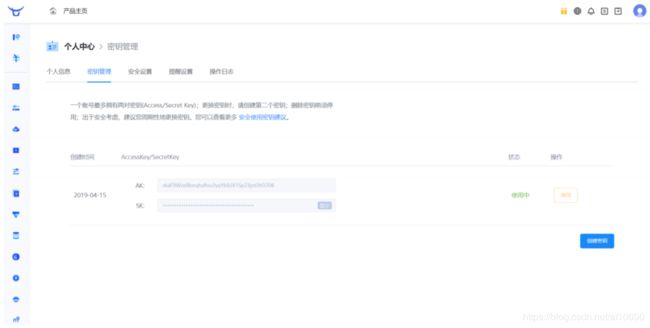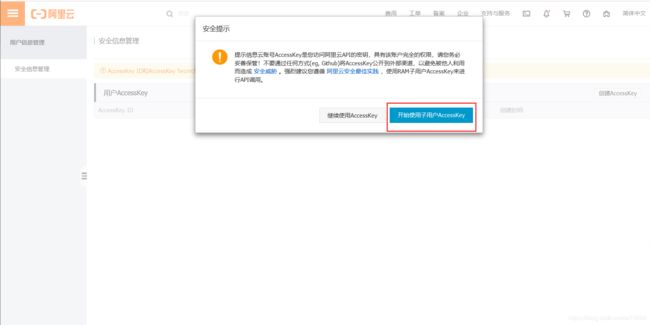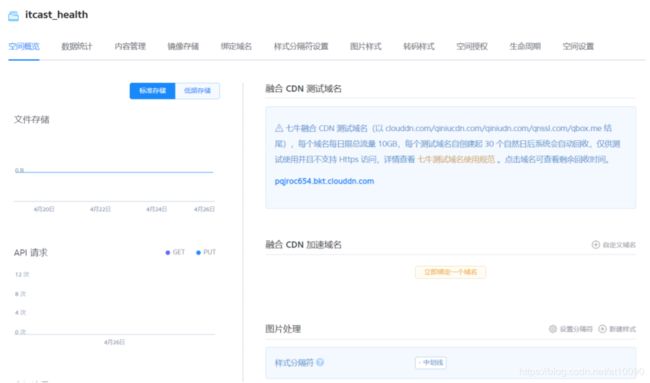图片云存储方案:阿里云OSS和七牛云操作步骤
1. 图片存储方案
#1.1 介绍
在实际开发中,我们会有很多处理不同功能的服务器。例如:
常见的图片存储方案:
- 方案一:使用nginx搭建图片服务器
- 方案二:使用开源的分布式文件存储系统,例如Fastdfs、HDFS等
- 方案三:使用云存储,例如阿里云、七牛云等
1.2.1 新建存储空间
-
七牛云
要进行图片存储,我们需要在七牛云管理控制台新建存储空间。点击管理控制台首页对象存储下的立即添加按钮,页面跳转到新建存储空间页面:可以创建多个存储空间,各个存储空间是相互独立的。
-
阿里云
搜索OSS对象存储,创建 Bucket,可以存储图片等数据。
1.2.2 查看存储空间信息
存储空间创建后,会在左侧的存储空间列表菜单中展示创建的存储空间名称,点击存储空间名称可以查看当前存储空间的相关信息,阿里云中可以在控制台中开通OSS服务,进行查看
1.2.3 开发者中心
进入开始者中心,查看入门文档
七牛云开发者中心,地址:https://developer.qiniu.com/
阿里云开发文档,地址https://help.aliyun.com/document_detail/32011.html?spm=5176.8465980.0.0.43e11450sZECjv
七牛云 Java SDK方式操作存储空间,地址:https://developer.qiniu.com/kodo/sdk/1239/java
阿里云 Java SDK 方式操作存储空间,地址https://help.aliyun.com/document_detail/52834.html?spm=a2c4g.11186623.6.758.278445dcCJUkyz
使用Java SDK操作七牛云需要导入如下maven坐标:
<dependency>
<groupId>com.qiniugroupId>
<artifactId>qiniu-java-sdkartifactId>
<version>7.2.0version>
dependency>
使用阿里云 Java SDK操作,需要导入的maven坐标
<dependency>
<groupId>com.aliyun.ossgroupId>
<artifactId>aliyun-sdk-ossartifactId>
<version>3.5.0version>
dependency>
1.2.4 鉴权
Java SDK的所有的功能,都需要合法的授权。授权凭证的签算需要七牛或阿里云账号下的一对有效的Access Key和Secret Key,这对密钥可以在相应平台方式获得.
七牛云管理控制台的个人中心(https://portal.qiniu.com/user/key)获得,如下图:
 阿里云:鉴权管理控制台的个人中心
阿里云:鉴权管理控制台的个人中心

1.2.5 Java SDK操作七牛云
我们就需要使用七牛云提供的Java SDK完成图片上传和删除,我们可以参考官方提供的例子。
//构造一个带指定Zone对象的配置类
Configuration cfg = new Configuration(Zone.zone0());
//...其他参数参考类注释
UploadManager uploadManager = new UploadManager(cfg);
//...生成上传凭证,然后准备上传
String accessKey = "your access key";
String secretKey = "your secret key";
String bucket = "your bucket name";
//如果是Windows情况下,格式是 D:\\qiniu\\test.png
String localFilePath = "/home/qiniu/test.png";
//默认不指定key的情况下,以文件内容的hash值作为文件名
String key = null;
Auth auth = Auth.create(accessKey, secretKey);
String upToken = auth.uploadToken(bucket);
try {
Response response = uploadManager.put(localFilePath, key, upToken);
//解析上传成功的结果
DefaultPutRet putRet = new Gson().fromJson(response.bodyString(),
DefaultPutRet.class);
System.out.println(putRet.key);
System.out.println(putRet.hash);
} catch (QiniuException ex) {
Response r = ex.response;
System.err.println(r.toString());
try {
System.err.println(r.bodyString());
} catch (QiniuException ex2) {
//ignore
}
}
//构造一个带指定Zone对象的配置类
Configuration cfg = new Configuration(Zone.zone0());
//...其他参数参考类注释
String accessKey = "your access key";
String secretKey = "your secret key";
String bucket = "your bucket name";
String key = "your file key";
Auth auth = Auth.create(accessKey, secretKey);
BucketManager bucketManager = new BucketManager(auth, cfg);
try {
bucketManager.delete(bucket, key);
} catch (QiniuException ex) {
//如果遇到异常,说明删除失败
System.err.println(ex.code());
System.err.println(ex.response.toString());
}
1.2.6 封装工具类
为了方便操作七牛云存储服务,我们可以将官方提供的案例简单改造成一个工具类,在我们的项目中直接使用此工具类来操作就可以:
package com.itheiheihei.utils;
import com.google.gson.Gson;
import com.qiniu.common.QiniuException;
import com.qiniu.common.Zone;
import com.qiniu.http.Response;
import com.qiniu.storage.BucketManager;
import com.qiniu.storage.Configuration;
import com.qiniu.storage.UploadManager;
import com.qiniu.storage.model.DefaultPutRet;
import com.qiniu.util.Auth;
import java.io.File;
import java.io.FileInputStream;
import java.io.InputStream;
/**
* 七牛云工具类
*/
public class QiniuUtils {
public static String accessKey =
"dulF9Wze9bxujtuRvu3yyYb9JX1Sp23jzd3tO708";
public static String secretKey =
"vZkhW7iot3uWwcWz9vXfbaP4JepdWADFDHVLMZOe";
public static String bucket = "qiniutest";
public static void upload2Qiniu(String filePath, String fileName) {
//构造一个带指定Zone对象的配置类
Configuration cfg = new Configuration(Zone.zone0());
UploadManager uploadManager = new UploadManager(cfg);
Auth auth = Auth.create(accessKey, secretKey);
String upToken = auth.uploadToken(bucket);
try {
Response response = uploadManager.put(filePath, fileName, upToken);
//解析上传成功的结果
DefaultPutRet putRet =
new Gson().fromJson(response.bodyString(), DefaultPutRet.class);
} catch (QiniuException ex) {
Response r = ex.response;
try {
System.err.println(r.bodyString());
} catch (QiniuException ex2) {
//ignore
}
}
}
//上传文件
public static void upload2Qiniu(byte[] bytes, String fileName) {
//构造一个带指定Zone对象的配置类
Configuration cfg = new Configuration(Zone.zone0());
//...其他参数参考类注释
UploadManager uploadManager = new UploadManager(cfg);
//默认不指定key的情况下,以文件内容的hash值作为文件名
String key = fileName;
Auth auth = Auth.create(accessKey, secretKey);
String upToken = auth.uploadToken(bucket);
try {
Response response = uploadManager.put(bytes, key, upToken);
//解析上传成功的结果
DefaultPutRet putRet =
new Gson().fromJson(response.bodyString(), DefaultPutRet.class);
System.out.println(putRet.key);
System.out.println(putRet.hash);
} catch (QiniuException ex) {
Response r = ex.response;
System.err.println(r.toString());
try {
System.err.println(r.bodyString());
} catch (QiniuException ex2) {
//ignore
}
}
}
//删除文件
public static void deleteFileFromQiniu(String fileName) {
//构造一个带指定Zone对象的配置类
Configuration cfg = new Configuration(Zone.zone0());
String key = fileName;
Auth auth = Auth.create(accessKey, secretKey);
BucketManager bucketManager = new BucketManager(auth, cfg);
try {
bucketManager.delete(bucket, key);
} catch (QiniuException ex) {
//如果遇到异常,说明删除失败
System.err.println(ex.code());
System.err.println(ex.response.toString());
}
}
}
将此工具类放在health_common工程中,后续会使用到
1.2.8 封装阿里云OSS工具类
同样也可以使用阿里云的OSS进行云端存储
下面是封装的工具类,要记得先要进引入坐标.
import com.aliyun.oss.OSS;
import com.aliyun.oss.OSSClientBuilder;
import java.io.ByteArrayInputStream;
/**
* 阿里云Oss
*
* @author at10090
*/
public class AliOssUtils {
private AliOssUtils() {
}
private static String endpoint = "http://oss-cn-shanghai.aliyuncs.com";
private static String accessKeyId = "" ;
private static String accessKeySecret = "" ;
//阿里Bucket(存储空间名)
private static String bucketName = "" ;
public static void uploadAliOss(String findPath, String fileName) {
String objectName = fileName;
// 创建OSSClient实例。
OSS ossClient = new OSSClientBuilder().build(endpoint, accessKeyId, accessKeySecret);
// 上传内容到指定的存储空间(bucketName)并保存为指定的文件名称(objectName)。
String content = findPath;
ossClient.putObject(bucketName, objectName, new ByteArrayInputStream(content.getBytes()));
// 关闭OSSClient。
ossClient.shutdown();
}
public static void uploadAliOss(byte[] bytes, String fileName) {
String objectName = fileName;
// 创建OSSClient实例。
OSS ossClient = new OSSClientBuilder().build(endpoint, accessKeyId, accessKeySecret);
// 上传Byte数组。
byte[] content = bytes;
ossClient.putObject(bucketName, objectName, new ByteArrayInputStream(content));
// 关闭OSSClient。
ossClient.shutdown();
}
public static void deleteFileFromAliOss(String fileName) {
// 创建OSSClient实例。
OSS ossClient = new OSSClientBuilder().build(endpoint, accessKeyId, accessKeySecret);
// 删除文件。
ossClient.deleteObject(bucketName, fileName);
// 关闭OSSClient。
ossClient.shutdown();
}
}


